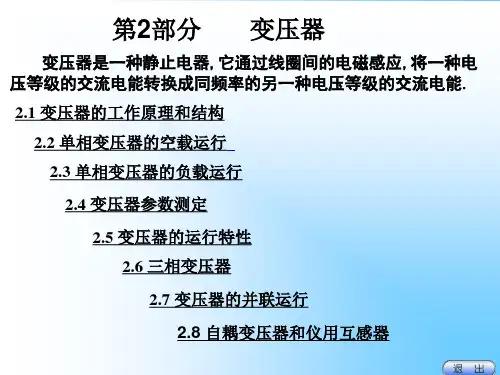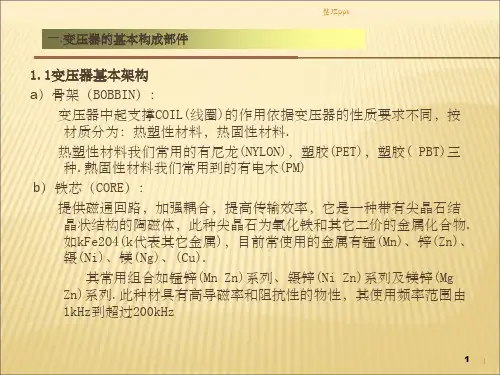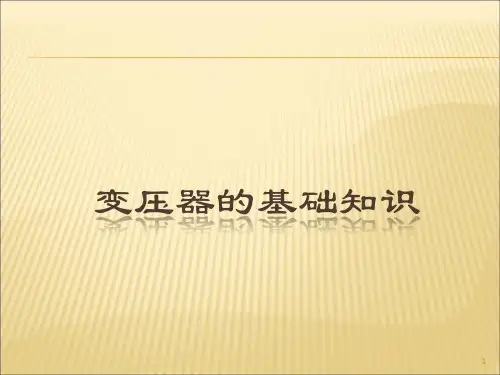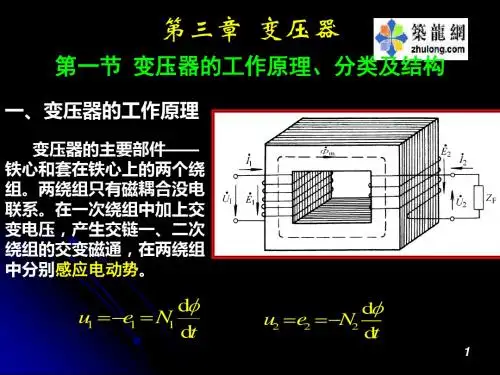变压器课件(英文)ABB Presentation
- 格式:ppt
- 大小:16.31 MB
- 文档页数:109







![ABB整流变压器[英语]](https://uimg.taocdn.com/e5f2f6fdc8d376eeaeaa31c2.webp)
Special Transformers Furnace and Rectifi er TransformersABB Oy Transformers has a long experience and lots of references from different applications, having a global responsibility within ABB for manufacturing special transformers.Our compact and low-weight transformers fully comply withthe customers’ specifi cations. The products are developedtogether with ABB’s system integrators, ensuring that thespecial requirements are always met.The high quality of our reliable products provides an out-standing capacity to withstand short circuits, harmonics,as well as fast and large load fl uctuations. Arc furnaces andelectrolysis operations also put tough stresses on trans-formers. Special type tests and quality control ensure safeoperation, while ABB’s product support and service network guarantee free-and-easy use of products.Furnace and rectifi er transformers manufactured by ABB Oy Transformers in Vaasa, Finland:• Transformers for diode and thyristor rectifi ers with or without OLTC• AC arc furnace transformers with or without OLTC• DC arc furnace transformersSafety and reliabilitySpecial attention is always paid to safety and reliability issues. Required transformer protection equipment, e.g. cooling system with redundancy, is delivered and provided according to project requirements.StandardsThe following standards govern the furnace and rectifi er transformers, and their application fi eld:TestingExtensive and heavy type testing programs have been performed for each design of the transformers to fulfi ll the special requirements of the customers. The test fi eld has a supply power of 150 MVA. It is also possible to arrange com-bined system tests.IEC IEEEIEC 60076 series IEEE C57.12.00IEC 61378-1IEEE C57.12.90IEC 60146IEEE C57.18IEC 60214Rectifi er transformers are combined with a diode or thyristorrectifi er. The applications range from very large aluminum electrolysis to various small and medium size operations. The transformers may have a built-in or separate voltage regulation unit for direct output regulation of diode rectifi ers,and correspondingly a power factor improvement with a thyristor rectifier.Electrolysis processes are used for the production of metals,such as aluminum, magnesium, copper and zinc, or chemicals,mainly chlorine. The largest installations are those for aluminum electrolysis with several transformer/rectifi er units in parallel operation to achieve the required DC current. In all cases the rectifier can be with diodes or thyristors.Electrolysis is generally considered to be a continuous andstable process, but with a constant high loading and currentharmonics.Due to a large variety of applications, there are severalinfl uencing factors to consider:• Rectifi er bridge connection: for medium to high DC vol- tage level.• Rectifi er single-way interphase connection: for low DCvoltage levels combined with high DC currents. • Thyristor or diode rectifi er.• Voltage range and step voltage.• Double-tier: HV and LV windings in two levels, and wye and delta connection to achieve a 12-pulse reaction.• Pulse numbers higher than 12: requires additional phase shifting windings.• LV winding arrangements: adapted to minimize the winding hotspots and infl uence of harmonics.• LV bushing arrangement: adapted to rectifi er design and to limit structural heating. Bushings are typically mountedon the tank side wall.Thyristor rectifi ers normally require transformer voltage regu-lation with a no-load tap changer (NLTC), if any. For small voltage regulation ranges the NLTC can be situated in a HV tapped winding. In comparison, diode rectifi ers have a longer range and a higher number of smaller voltage steps in the transformer. A multi-coarse-fi ne on-load tap changer (OLTC) or an OLTC/NLTC combination is preferred, together with LV-side saturable reactors for the voltage fi ne-tuning. The required double-wound or auto-connected regulating transformer can, depending on transport or site limitations, be built into the same tank as the rectifier transformer, or into a separate tank.For various electrolysis and smelting applications, such as aluminum and other metals and chlorine.An active part of the rectifi er transformer with the Inter Phase Transformer.An AC furnace transformer with side-mounted secondary bushings.Furnace transformers for long-arc (steel) and short-arc (ferro-alloy) operations.ABB produces transformers for all furnace applications. A robust design guarantees mechanical strength for steel furnace operation and temperature control for continuous high loads in ferro-alloy operation.Arc furnaces are used in steel industry for smelting scrap iron and for refi ning steel. Other application areas are:•Smelting glass and ceramics• Manufacturing or refi ning many other materials, e.g. ferrochromium, ferromanganese, different abrasive materials (oxides and nitrides), semiconducting base materials, nanopowders etc.Electric arc furnace (EAF) transformers are required for many different furnace processes and applications. They are built for:• Steel furnaces, mainly long arc • Ladle furnaces• Ferro-alloy furnaces and similar with short or submerged arc• Smelting of other materialsSteel arc furnace transformers operate under very severe conditions with regard to frequent overcurrents and over-voltages generated by short-circuits in the furnace and the operation of the HV circuit breaker (“furnace breaker”). The loading is cyclic, while in other applications the loading is more continuous at high utilization.Electric Arc Furnaces (EAF) can be either of AC or DC arc furnaces. The power ratings of these transformers are 20...200 MVA. Reactors are often needed to smoothen the fl uctuations, either in the same tank or in a separate unit. Ladle furnaces (LF) are AC furnaces typically of 3...40 MW. The application is less demanding for the transformer than smelting, because the arc is rather stable. The arcing occurs between the electrodes and the molten steel.ABB’s EAF transformers are rigidly designed to withstand repeated short-circuit conditions and high thermal stresses. They are also protected against operational overvoltages due to frequent switching.Design options:• Direct or indirect regulation• On-load or no-load tap changer (OLTC or NLTC)• Built-in reactor for long-arc stability• Secondary bushing arrangements and designs, air or water cooled• Internal secondary phase closure (internal delta)• RC-SA high voltage protection systemDC arc furnaces are mainly for steel production.Transformers for DC furnace operation are normally providedin a transformer/rectifi er package. DC furnaces are typicallyone of the largest arc furnaces. The full package can bemanufactured and supplied by ABB.Being a rectifi er transformer for furnace operation, the DCfurnace transformer has to withstand the characteristicstresses of furnace operation, as well as the additionalstresses related to rectifi er operation, including generatedcurrent harmonics. Also, the HV side needs to be protectedfrom frequent switching overvoltages.An AC arc furnace transformer of 36 MVA with the secondary current of 97 kA.Most large DC arc furnaces are built for steel production. Theuse of a thyristor rectifi er for the conversion to DC normallyreduces the requirement for on-load voltage regulation of thefurnace transformer. The step voltages are larger than for anAC furnace transformer, and a no-load tap changer (NLTC) isadequate in many applications.DesignDC furnace transformers are mostly built with two axiallydisplaced LV windings, normally one connected in delta andone in wye, each having a separate high voltage winding. Inthis double-tier design the transformer is connected to twosix-pulse rectifi ers, adding up to a 12-pulse system or twoparallel 6-pulse systems. The regulation of the LV transformervoltage is normally done by using a NLTC in the primarywinding. The location of the 6-pulse rectifi ers can be onthe same side of the transformer or on opposite sides, asrequired by the plant layout.ReferencesABB Oy Transformers in Vaasa, Finland has supplied fur-nace and rectifi er transformers to main steel and copperproducers, as well as leading chemical companies aroundthe world.The ABB Oy Transformers factory is located in Strömberg Park, Vaasa.。